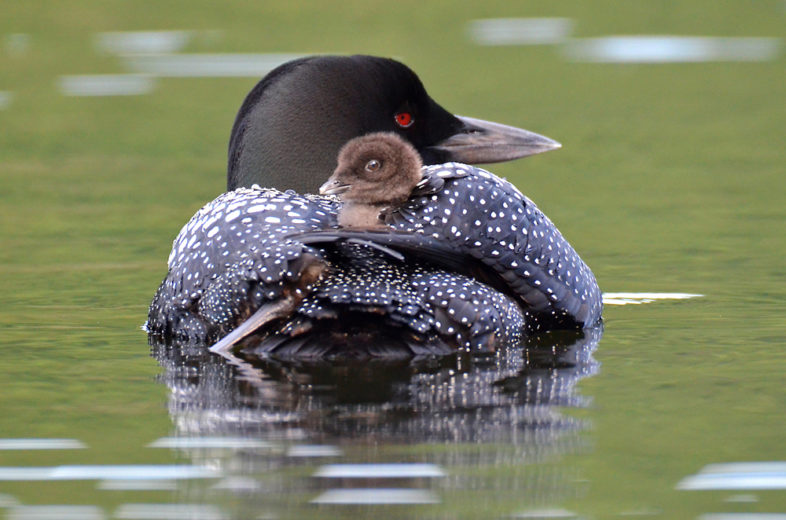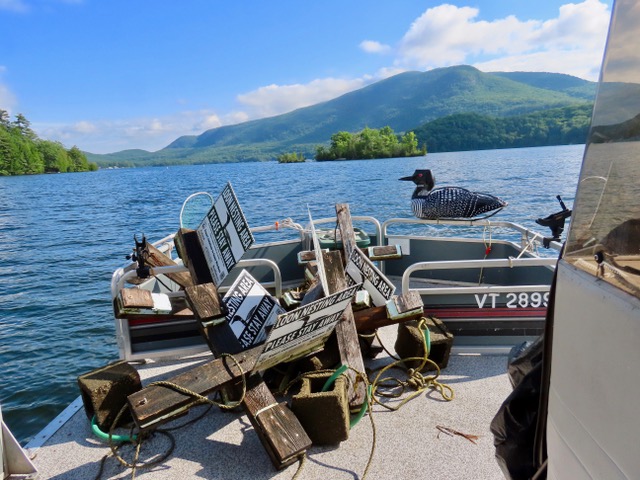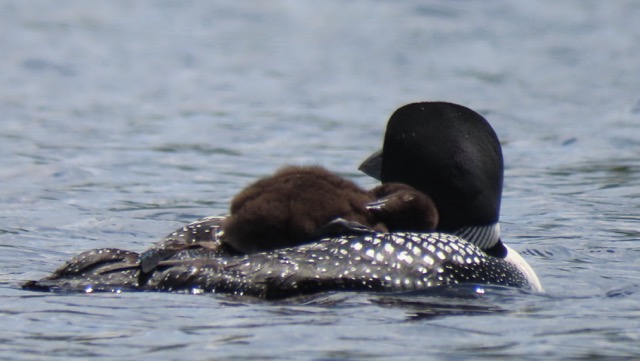
What a way to travel! Just a few days after hatching, a chick is ferried around Bald Hill Pond in the lap–er, back–of luxury (photo taken in summer 2019). This summer’s loon pair on Bald Hill Pond started nesting this past weekend for one of the latest start dates recorded in Vermont. / © Lorna Kane Rohloff
It’s mid-July, height of “loon season,” and just a few days away from Vermont’s 38th annual LoonWatch Day on Saturday, July 18. Each year on the third Saturday of July, we survey more than 160 lakes and ponds statewide with the help of a corps of LoonWatch volunteers–it’s an incredibly effective way for VCE to document and track loon populations across Vermont. Interested in joining us? Visit our website to learn more about LoonWatch Day, the Vermont Loon Conservation Project, and how you can get involved! This year we have good coverage and there are just a few lakes that still need volunteers; but you can always help with our Casual Lake Survey program by visiting lakes at any time.
It’s also time for a quick update from Vermont’s lakes and ponds. Thus far, it appears that loon nesting numbers in Vermont will be lower this year. We’ve confirmed 88 nests, but have several ponds yet to paddle that may harbor nests based on single-loon observations (is the mate on-nest out of sight?). If you’re looking for an excuse to explore, visit the shores of Stiles Reservoir, Molly’s Pond, Beecher Pond (private access only), and Long Pond in Greensboro and let me know what you find. We have yet to visit Bourn Pond–which entails a three-mile hike in the southern Green Mountains–but Henry Dandeneau, our intrepid southern Vermont loon volunteer, plans to hike in on LoonWatch Day after he finishes surveying the 2000-acre Somerset Reservoir to check on its three resident loon pairs.

Mike and Rosie Korkuc collect nest warning signs from Lake Dunmore after a successful hatch. © Mike Korkuc
We’ve observed many loon pairs climbing on old nest sites and rafts, but not following through with continued nest building and egg laying. These could be newly-formed pairs as a result of a mate switch, or perhaps interactions with “extra” loons delayed nesting activity and now it’s too late. Last year we observed 101 nest attempts–representing an unusually high percentage of the loon population nesting–so this year may turn out to be more normal, with a higher percentage of loon pairs taking the year off.
This summer we recorded one of the earliest nests ever. The loon pair on Kent Pond began nesting in early May with a resulting early hatch on June 4th. On the other end of the spectrum, four pairs started nesting in the last week of June and early July, and one of the latest nests recorded started between July 11 and 13 on Bald Hill Pond; all of these were first-time nests, not re-nests. The only new nest this year was confirmed on Collins Pond, but we’re afraid the pair might be incubating too long (are the eggs non-viable, or has embryo development stopped?). Two new pairs started nest building but never laid eggs on Halls Lake in Newbury and Glen Lake in Castleton.

Nap time on Branch Pond. © Nicki Steel
Let me know if you need an excuse to paddle in the latter half of August, and I’ll send you a list of lakes that will need loon chick follow-up surveys. Thank goodness COVID-19 has not come roaring back in Vermont so we can all escape to the waters for some rest and relaxation. Stay safe out there.

We saw loons with a chick on long pond, Greensboro, vt today.